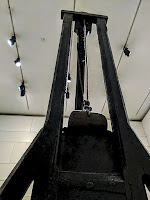We're in Edinburgh for the week. Small as it is, this city holds some important pieces of the puzzle like Mary, Queen of Scots who ruled Scotland from 1542 to 1567.
Standing in her private supper chamber in the tower of the Palace of Holyroodhouse, Mary and her tragic reign became disturbingly real. One March evening in 1566 she was dining there with friends including
David Rizzio, her private secretary, when her husband
Lord Darnley suddenly entered the room, sat beside her and slipped his arm around her back. Then Lord Ruthven, dressed in full armor, entered and announced to the Queen that Rizzio had offended her honor and should come with him. Understanding the situation, Mary ordered Lord Ruthven to leave. The rest, as they say,
is history. A screaming Rizzio was dragged into the larger adjoining chamber,
stabbed 56 times and tossed down the stairs. His body was buried soon after in an unmarked grave.

By William Allan - Guildhall Art Gallery, Public Domain, Link
Knowing she was the real target of the conspiracy, the Queen skillfully
persuaded 21-year-old Darnley to abandon his alliance with the Lords. To insure succession of the monarchy to her unborn child, she needed him at the birth to confirm the child was his. Two days after Rizzio's murder, they escaped the palace together through an underground passage. Nine days later, Mary re-entered the city accompanied by three to five thousand troops and moved into the fortress of
Edinburgh Castle to prepare for the birth of her son. Her enemies fled to England, everyone that is, but Lord Darnley. He stayed in Edinburgh and, over the next few months, seemed close to reconciling with Mary but many cross-currents moved below the surface. Eleven months after Rizzio's murder, the lodge where he was staying exploded. Darnley didn't die in the explosion. He and his valet were found dead in the orchard. Both appeared to have been
strangled to death. Two and a half months after Darnley's death the Queen married the Earl of Bothwell, the man accused and acquitted of Darnley's murder. However, the intrigue and power games did not end there. A year later the Queen was forced to abdicate her throne to her infant son and flee to England where she remained prisoner of her cousin Queen Elizabeth I until her beheading 20 years later.
The National Museum of Scotland held another crossroads of dusty history and bloody reality for it
was there we met The Maiden, Edinburgh's guillotine. We were strolling around, looking at medieval and renaissance artifacts . . . armor, swords, coin hoards, skeletons, carvings and the like when we came upon The Maiden. It stood apart from the rest of the collection like a forlorn and naked wraith trapped in the light of day. It was real like nothing else in the museum and so terribly out time and place. Looking up at it I felt like I was being sucked into a treacherous undertow. But back to the history part.
 |
| The Maiden |
Public beheadings were so frequent during Mary's reign that in 1563 the official executioner's sword had worn out, forcing the city to rent one. It was then that
James Douglas, the 4th Earl of Morton, suggested the city purchase The Maiden. The city magistrates liked the idea and the guillotine became Edinburgh's new official means of decapitation.
More than 150 people were publicly executed on The Maiden between 1564 and 1710. It even played a part in the drama surrounding Mary, Queen of Scots. James Douglas, the 4th Earl of Morton, the man who introduced the guillotine to the city, was (falsely?) convicted of participating in Lord Darnley's murder. Of course he denied it all, "art and part", but was executed anyway on 2 June 1581. Such is the way when leaders enjoy absolute, unchecked power. Douglas's corpse remained on the scaffold until being buried the next day in an unmarked grave. His head however, as a lesson for all, remained on a spike outside St Giles Cathedral for eighteen months.
Holyroodhouse is the official residence of the British monarchs in Scotland and, by tradition, Queen Elizabeth II spends one week there every year in the spring.













